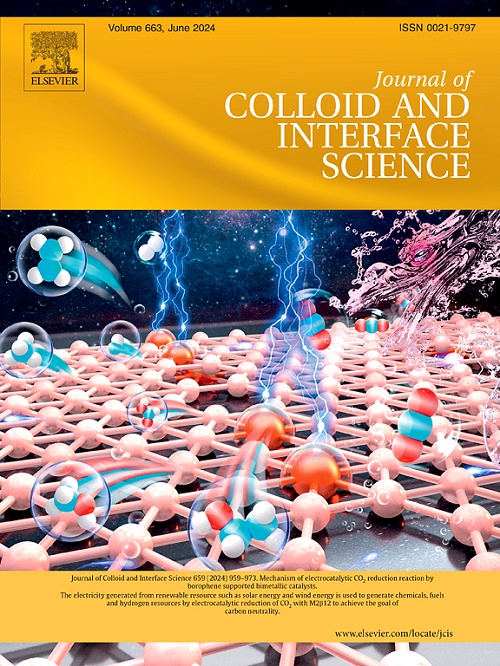Construction of tough hydrogels based on heterostructure double crosslinking strategy for flow control in harsh reservoirs
IF 9.4
1区 化学
Q1 CHEMISTRY, PHYSICAL
引用次数: 0
Abstract
Polymer hydrogels, as an effective technology that significantly reduces plugging in highly permeable formations, have been demonstrated to have important applications in deep profile control and enhanced recovery in complex reservoirs. While conventional preformed particulate gels (PPGs) have limited mechanical strength and thermal stability after swelling, restricting their practical application in oilfields. To construct a heterostructure double crosslinking structure hydrogel, methacrylated lignosulfonate (MLS) was synthesized as crosslinking agent and reacted with N, N′-methylenebisacrylamide (MBA) and functional monomers, including acrylamide (AM), acrylic acid (AA), N-methylolacrylamide (NMA), and 2-acrylamido-2-methylpropane sulfonic acid (AMPS). MLS acts as a macromolecular crosslinker that can interact with monomers such as AM, AA, AMPS, and NMA, forming heterogeneous crosslinked network through covalent (chemical bonds) and physical interactions (hydrogen bonds and π-π stacking). Its long-chain topology can also form a loosely connected primary network with the monomers, which is able to form a mechanical complementary effect with the short-chain localized network of MBA, thus realizing the optimization of the hydrogel mechanical properties and swelling properties. The hydrogels demonstrated remarkable mechanical properties, including a superior modulus of elasticity (G′ = 42,368 Pa), high strength (0.14 MPa), and excellent toughness (2.96 MJ⋅m−3). Additionally, their swelling behavior was evaluated under varying temperature and salinity conditions, revealing that hydrogels maintained stable performance even under harsh environmental. Water-driven tests conducted in natural fractured rock cores showed that the hydrogel achieved a breakthrough pressure of 194 psi/ft at a flow rate of 0.5 mL/min, effectively meeting the water-plugging requirements for high temperature and salt reservoirs.

基于异质结构双交联策略的强韧水凝胶构建及其在恶劣储层中的控制作用
聚合物水凝胶作为一种有效的技术,可以显著降低高渗透地层的堵塞,在复杂油藏的深层调剖和提高采收率方面有着重要的应用。而传统的预成型颗粒凝胶(PPGs)在膨胀后的机械强度和热稳定性有限,限制了其在油田中的实际应用。以甲基丙烯酸木素磺酸盐(MLS)为交联剂,与N, N ' -亚甲基双丙烯酰胺(MBA)、丙烯酰胺(AM)、丙烯酸(AA)、N-甲基丙烯酰胺(NMA)、2-丙烯酰胺-2-甲基丙烷磺酸(AMPS)等功能单体反应,制备了异质结构双交联水凝胶。MLS作为大分子交联剂,可与AM、AA、AMPS和NMA等单体相互作用,通过共价(化学键)和物理相互作用(氢键和π-π堆叠)形成非均相交联网络。它的长链拓扑结构还能与单体形成松散连接的初级网络,与MBA的短链局域网络形成力学互补效应,从而实现水凝胶力学性能和溶胀性能的优化。该水凝胶具有优异的弹性模量(G′= 42,368 Pa)、高强度(0.14 MPa)和优异的韧性(2.96 MJ·m−3)。此外,在不同的温度和盐度条件下评估了它们的膨胀行为,表明即使在恶劣的环境下,水凝胶也能保持稳定的性能。在天然裂缝岩心中进行的水驱测试表明,在0.5 mL/min的流速下,水凝胶达到了194 psi/ft的突破压力,有效满足了高温油藏和含盐油藏的堵水要求。
本文章由计算机程序翻译,如有差异,请以英文原文为准。
求助全文
约1分钟内获得全文
求助全文
来源期刊
CiteScore
16.10
自引率
7.10%
发文量
2568
审稿时长
2 months
期刊介绍:
The Journal of Colloid and Interface Science publishes original research findings on the fundamental principles of colloid and interface science, as well as innovative applications in various fields. The criteria for publication include impact, quality, novelty, and originality.
Emphasis:
The journal emphasizes fundamental scientific innovation within the following categories:
A.Colloidal Materials and Nanomaterials
B.Soft Colloidal and Self-Assembly Systems
C.Adsorption, Catalysis, and Electrochemistry
D.Interfacial Processes, Capillarity, and Wetting
E.Biomaterials and Nanomedicine
F.Energy Conversion and Storage, and Environmental Technologies

 求助内容:
求助内容: 应助结果提醒方式:
应助结果提醒方式:


